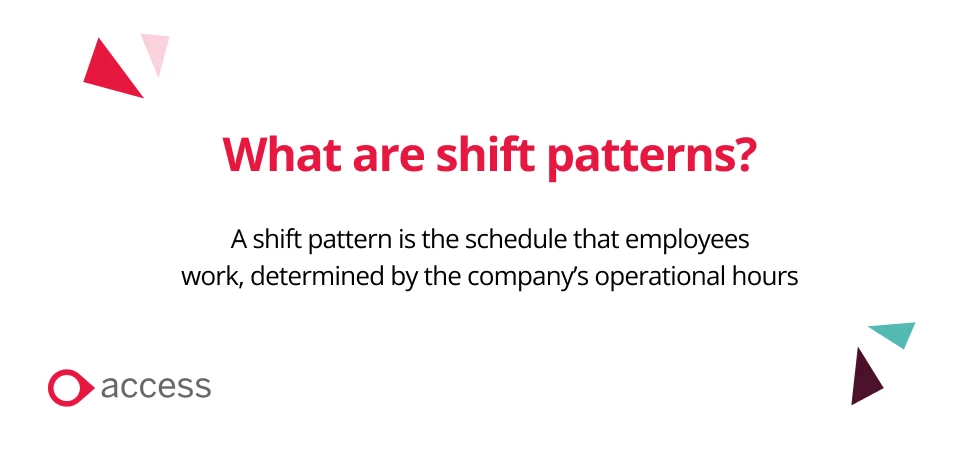
In response to operational demands, many businesses choose adopt shift patterns to optimise productivity and ensure adequate cover. These are determined by the needs of the business, but for companies that operate outside of the standard 9-5 Monday to Friday working model, schedules can vary significantly.
With numerous work patterns available, determining which is most suitable for your business can be challenging. In this article, we will explore seven different shift models, provide work pattern examples for each, and discuss three ways to manage shift working patterns effectively.
What are shift patterns?
A shift pattern is the schedule that employees work, determined by the company’s operational hours. Shift patterns usually include a mix of morning, afternoon and evening work and may also involve night shifts too. In typical shift patterns, employees work a set schedule each week with days off in between, often working a minimum of five days per week but never more than seven in a row. Some frequently used shift patterns include:
- Two-shift
- Four on, four off
- Night work
- Staggered day
While the concept of a shift patten and rota systems used to be reserved for businesses working in the hospitality, retail and healthcare industries, with the rise in flexible and hybrid working models, it is now more common for others to use the process too. Shift work patterns can vary based on the job or industry, but by managing these effectively, businesses can ensure they meet work demands and have suitable cover where needed. What types of shift patterns are there?
What types of shift patterns are there?
With so many different shift pattern options available, small businesses may find it difficult to understand the meaning behind each of them and how they work in practise. Let’s look at seven common types of shift working patterns and provide an example for each.
Two-shift
A two-shift patterns involves rotating two different shifts which cover the entire day. Typically implemented for Monday to Friday working hours, there is usually a morning shift and an evening shift.
- Example of two-shift pattern
The morning shift worker might start work at 6am and finish at 2pm, while the evening shift takes over from 2pm and finish at 10pm, providing cover throughout the day.
Four on, four off
The four on, four off work pattern requires an employee to work four days consecutively, then have four days off. The four days on usually consists of 12-hour shifts each.
- Example of four on, four off shift pattern
A nurse may work from 7pm to 7am for four consecutive nights as part of their four-shift pattern. Once completed they would then have the next four days off to rest before returning to work.
Night shift
An employee will work throughout the night, with the shift usually starting in the evening and finishing the following morning. This schedule is often required for 24-hour operations such as security or healthcare.
- Example of night shift pattern
An example of night shift patterns would be a security guard working from 10pm to 6am. In this instance they may be monitoring surveillance cameras to ensure the security of the premises during quieter night-time hours.
Weekend
Weekend shift work patterns take place over Saturdays and Sundays but can sometimes include Fridays depending on the business. This is common for those in the hospitality industry, where busy weekends require full staff coverage.
- Example of weekend shift pattern
A restaurant worker may be required to work full days over Saturday and Sunday but have rest days during the week.
Staggered day
A staggered day shift pattern usually consists of five eight-hour days over the course of a seven-day week. Start times are staggered throughout the day to accommodate operational needs.
- Example of staggered day shift pattern
For operational hours outside of a 9-5 schedule, such as 9am to 9pm, employees may be expected to start at 9am, 11am, and 1pm respectively, which will cover the entire 12-hour day.
Twilight and evening
Twilight and evening shift working patterns are started late afternoon and go into the evening, usually between 5pm and 9pm. This option is popular for retail as it accommodates customers who are shopping after regular business hours.
- Example of twilight and evening shift pattern
A retail store might schedule its sales associates to work from 3pm to 9pm, or until the store closes.
Continental
For a continental shift pattern, employees work a rotating schedule which provides 24-hour coverage, including both day and night shifts. Instead of everyone working the same hours each day, they take turns working different shifts.
- Example of continental shift pattern
A transportation worker may have three day shifts followed by two days off, then three night shifts then a four-day break.
What laws impact shift work pattern regulations in the UK?
The Working Time Regulations 1998 are a set of laws which establish how much an employee can work within a set period of time. It is crucial for businesses to understand these regulations when planning and implementing shift work patterns.
The regulations dictate that:
- An employee can work no more than 48 hours a week
- A 20-minute rest period for every six hours worked is provided
- Employees are offered a minimum daily rest period of 11 consecutive hours between working days
There are also provisions in place for young workers and those who work night shifts, so these must be taken into consideration too. Our article on Working Time Regulations explains the topic in more detail.
3 ways to manage shift working patterns effectively
Once you have grasped the different shift work patterns and chosen the right one for your specific operational needs, your next step is to implement accordingly. However, it is important to manage this correctly both to maximise your outputs and for employee satisfaction.
Here are 3 ways to manage shift working patterns successfully:
1. Understand business needs
When looking at shift working patterns, it is crucial to have an understanding of business needs and the staff availability. This means that employers can design shift schedules that boost productivity while also taking into account busier periods or seasonal needs alongside the all-important legal requirements.
2. Ensure transparency and clear communication
By offering employees details of their work schedules well in advance, you can ensure shifts run smoothly. It is also important to have open communication with employees about their preferences and availability when making rota-based decisions. For example, if an employee prefers to work a morning or evening shift and this fits in with the rota, then try to accommodate this where possible.
3. Utilise timesheet software
Using cloud-based timesheet software can help to simplify the scheduling of shift patterns, as well as offer visibility and easy tracking options to both employees and employers. By tracking the attendance of employees using automated timesheets, you can gain insights into what shift patterns work best for your needs and make data-driven decisions.
How can PeopleHR help you with shift pattern management
Our Timesheet Software can assist you in managing your chosen shift patterns with ease, offering scheduling, tracking and self-serve functionalities. Find out how our suite of HR Software can help your business thrive, get in touch today.
